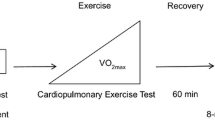Abstract
Cardiovascular responses were examined in seven healthy male subjects during 10 min of recovery in the upright or supine position following 5 min of upright cycle exercise at 80% peak oxygen uptake. An initial rapid decrease in heart rate (f c) during the early phase of recovery followed by much slower decrease was observed for both the upright and supine positions. The average f c at the 10th min of recovery was significantly lower (P < 0.05) in the supine position than in the upright position, while they were both significantly greater than the corresponding pre-exercise levels (each P < 0.05). Accordingly, the amplitude of the high frequency (HF) component of R-R interval variability (by spectrum analysis) in both positions was reduced with a decrease in mean R-R interval, the relationship being expressed by a regression line – mean R-R interval = 0.006 × HF amplitude + 0.570 (r = 0.905, n = 28, P < 0.001). These results would suggest that the slower reduction in f c following the initial rapid reduction in both positions is partly attributable to a retardation in the restoration of the activity of the cardiac parasympathetic nervous system. Post-exercise upright stroke volume (SV, by impedance cardiography) decreased gradually to just below the pre-exercise level, whereas post-exercise supine SV increased markedly to a level similar to that at rest before exercise. The resultant cardiac output (Q˙ c) and the total peripheral vascular resistance (TPR) in the upright and supine positions returned gradually to their respective pre-exercise levels in the corresponding positions. At the 10th min of recovery, both average SV and Q˙ c were significantly greater (each P < 0.005) in the supine than in the upright position, while average TPR was significantly lower (P < 0.05) in the supine than in the upright position. In contrast, immediately after exercise, mean blood pressure dropped markedly in both the supine and upright positions, and their levels at the 10th min of recovery were similar. Therefore we concluded that arterial blood pressure is maintained relatively constant through various compensatory mechanisms associated with f c, SV, Q˙ c, and TPR during rest and recovery in different body positions.
Similar content being viewed by others
Author information
Authors and Affiliations
Additional information
Accepted: 4 September 1999
Rights and permissions
About this article
Cite this article
Takahashi, T., Okada, A., Saitoh, T. et al. Difference in human cardiovascular response between upright and supine recovery from upright cycle exercise. Eur J Appl Physiol 81, 233–239 (2000). https://doi.org/10.1007/s004210050036
Issue Date:
DOI: https://doi.org/10.1007/s004210050036



